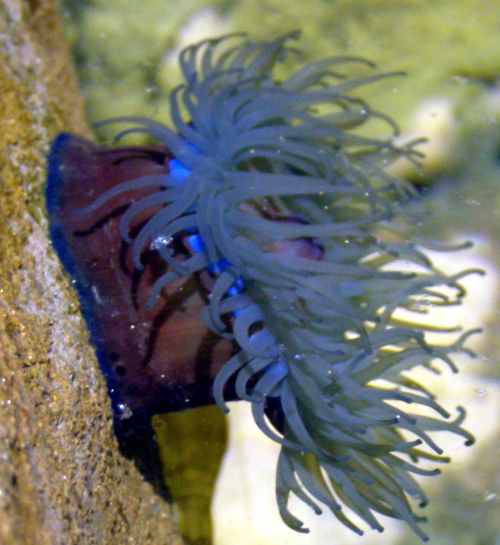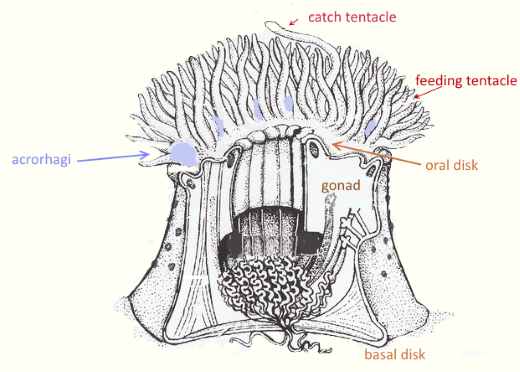The beadlet anemoon
This is a most common sea anemone that can be found in the intertidial zone on Atlantic rocky shores. The beadlet anemone is most abundant on the lower shore, particularly on exposed coasts, but is also found on the middle and upper shore, especially in rock pools, as well as in damp crevices. This anemone is highly adative and withstands strong waves, high temperatures, direct sunlight and rapid changes in salinity, caused by rain.

A beadlet anemone attached with a broad foot to a rock: The blue ring is called acrorhagi: They are blue knobs around the mouth, and are used to defends itself.
The beadlet anemoon out of the water
The beadlet anemone protects itself by producing mucus, and retracting is tentacles. This ability protects against drying out and makes it able to survive above the tide line The anemone is strongly attached to the rocks by its strong foot. It takes the form of a round blob in the colors orange or brown or red, this way offering the smallest amount of surface to the sun, waves and sandparticles.
The beadlet anemone submerged underwater
Technically, beadlet anemones are sedentary, since they are capable of very slow movement, but in terms of feeding they are regarded as sessile sit-and-wait predators that appear to feed on whatever falls onto the tentacles and oral disc. They beadlet anemone move around the rocks just like a snail: it producus mucus, gliding slowly over this mucus layer. Small creatures like prawns, insects and mussels are catched by theire feeding tentacles. But also seeds and terrestrial plant debris is eaten. In captivity they can be fed with fish flakes.
The beadlet anemone reproduction
There are two ways of reproduction: the asexual way is by budding: These clones remain attached to the rock and go there own way. The sexual reproduction is done by swimming spermatazoids, produced by the male beadlet sea anemone, entering the female cavity: here they fuse with the eggs, and are brood internally to form peleagic larvae.

Sponges and sea anemones from P. Kuckuck: "der Strandwanderer", 1905.
1 Breadcrumb Sponge or Halichondria panicea
2 Mermaid's Glove or haliclona oculata of axinella oculata
3 Boring Sponge or Cliona celata
4 Christmas Anemone or Urticina crassicornis or Tealia crassicornis
5 Beadlet Anemone or Actinia equina
6 Plumose Anemone or Actinoloba dianthus
7 Mud Sagartia or Cave-dwelling Anemone or Sagartia troglodytes
8 Dead Man's Fingers or Alcyonium digitatum
The beadlet anemone fighting
This anemone is territorial towards other anemones. First they make contact with the feeding tentacles: The acrorhagi, the blue knobs around the mouth, are the inflated: these acrorhagi contain the stinging cells.
Then the acrorhagi made contact with the opponent: The beadlet anemone stretches to opponent: Acrorhagial peels are placed on the opponents skin and bring damage to the opponent. They one that looses moves away.
In the fights the anemones follow simple logic in attacking and defending themselves. The decisions they make are the same as in other animal groups, like crabs. But crabs have (small) brains, anemones doesnt. It is not clear how the anemone can make those decisions.
source: Foster NL & Briffa M. 2014. Familial strife on the seashore: Aggression increases with relatedness in the sea anemone Actinia equina.

Beadlet sea anemone anatomy.